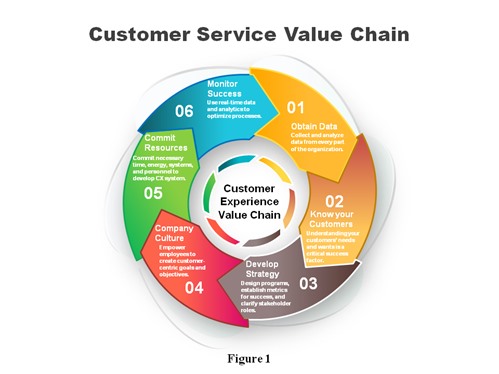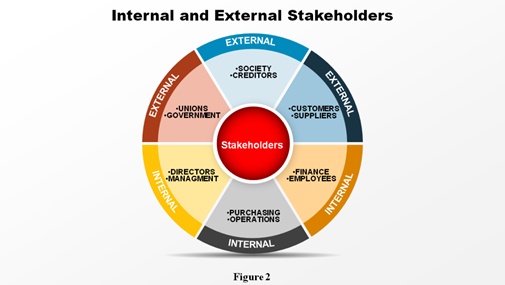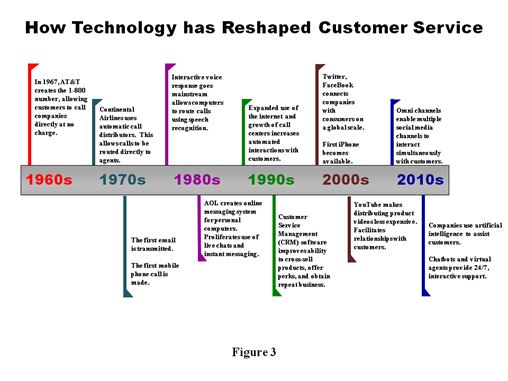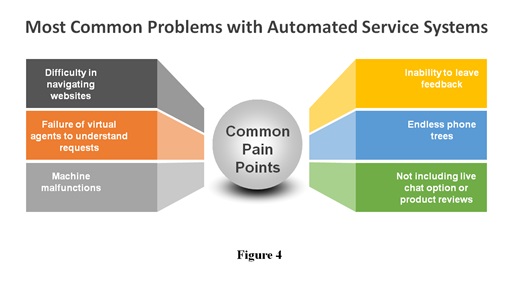
Emergent technologies have forever changed traditional customer service support. In this in-depth article, Reina G. Wiatt and Jolene A. Lampton look at the state of customer service in the digital age.
Telephone assistance, written letters, and face-to-face interaction—once staples of the office landscape—are no longer sufficient to meet the changing needs of today’s global marketplace. Rising customer expectations and increasing brand loyalty competition are driving the need to provide greater value-driven service to both consumers and stakeholders.
According to customer service expert Shep Hyken, a majority of businesses believe that improving the total customer experience is a top priority and will overtake price and product quality as a key differentiator by 2020.
Businesses of all sizes are adopting an integrative approach to deliver the best possible customer experience throughout the product life cycle. This differs from supply chain management, which monitors the activities and resources required to bring a product to market. In contrast, a value chain (see Figure 1) interconnects end-to-end business operations with a qualitative framework to enhance customer’s expectations across all contacts with a company.
Stakeholder considerations, new technologies, and shifting demographics are all influential factors to maximize both tangible and intangible benefits in the value chain.

Stakeholder Theory and the Value Chain
A business ecosystem is a set of value-creating relationships among its members and can include customers, suppliers, employees, financiers, communities, and managers. To understand a business is to know how these relationships interoperate with each other.
Stakeholders—internal or external persons, companies, or social groups—have a vital interest in a company’s actions, policies, and objectives. Stakeholders may include suppliers, unions, governmental agencies, creditors, directors, employees, and the community from which the company draws its resources (see Figure 2).

Stakeholders have interconnected joint interests with each other. For instance, an employee can be a stockholder; a supplier can be an employee or customer; and government officials can also be consumers. This interconnectivity enables us to analyze the customer’s perceptions of value through a holistic lens.
The IMA’s Statement on Management Accounting (SMA) Value Chain Analysis for Assessing Competitive Advantage (issued in March 1996) states, “The value chain approach for assessing competitive advantage is an integral part of the strategic planning process.3For example, a critical role of the Chief Executive Officer is to manage and shape relationships to ensure that products and services remain viable.
Firms seeking to improve performance will analyze all phases of the value chain, leveraging new technologies that play an essential role in delivering a seamless experience, increasing profits, and generating customer loyalty.
Increasing Role of Technology in Customer Service
As retail automation technology takes quantum leaps forward (see Figure 3), companies that provide value-driven information across multiple touchpoints will differentiate themselves from those who employ single channel or siloed environments. As intelligent automation draws useful insights from purchasing and retail trends, businesses can use this data to improve overall service.
Omni-channels, chatbots, artificial intelligence, and e-commerce represent new cornerstone technologies to achieve that goal. These digital disrupters are reshaping the customer service landscape and are rapidly unseating traditional communication channels. From mobile devices to the most sophisticated intelligent machines, increased automation is helping companies of all sizes to optimize the customer experience.

Omni-channels. Support channels enable businesses to provide customers with information, solve problems, and respond to complaints. While retailers utilize a wide range of support options such as human and virtual agents, social media, or mobile apps, existing single and multi-channel support systems necessitate access to each channel separately. In contrast, omnichannels avoid adding new digital technologies to an already siloed system.
Instead, they thread backend systems into a single platform with multiple-access touchpoints. This collaborative integration enables customers to share feedback, allows messaging across multiple touchpoints, and provides live connections to retailers. The Kantar Retail Global study reports that by 2020, omnichannels will decouple separate physical and virtual platforms into a combined, seamless shopping experience11.
Chatbots. From multilingual programming to natural language capabilities, chatbots (‘bots’) are quickly moving beyond today’s stilted scripts and limited interactive proficiencies. Sophisticated algorithms coupled with artificial intelligence (AI) will allow bots to handle repetitive, simple tasks so that human agents have more time to assist customers with more difficult questions.
Bots offer multilingual capabilities, 24/7 availability, multiple platform access, and can assist numerous customers simultaneously to resolve complaints. Once completed, the resulting feedback posts instantly across social media channels, departments, various stakeholders, and websites without human assistance.
Artificial Intelligence. Innovation is a crucial driver to achieve superior customer service, and artificially intelligent cognitive applications will include sophisticated predictive analytics, speech pattern recognition, and contextual understanding combined with interactive communication.
When integrated with bots and virtual agents, AI can vault support services beyond scripted responses to assist with resolving more complex customer issues in call centers or support departments.
According to a recent study conducted by Gartner Research, 15 percent of all customer service interactions will be handled entirely by AI by 20201. For example, Humana, one of the largest insurance providers, employed IBM’s Watson voice assistant to answer routine inquiries and route calls to agents. The AI-based system provides faster service and now handles over 7,000 calls from 120 providers per day6.
E-commerce. With global online retail sales expected to exceed $6 trillion dollars by 20239, companies like Ace Hardware, Amazon, Wal-Mart, and Home Depot are leveraging e-commerce capabilities to add speed and new delivery options for consumers.
Wal-Mart and Home Depot are spending billions to shorten delivery times no matter the size of the product, and Amazon’s Prime Service Now provides same-day delivery service for eligible items. Ace Hardware has 75 percent of U.S. Households located within 15 minutes of its stores and uses employees with knowledge about the products to make deliveries to their neighbors.
Ace Hardware believes this provides far better assistance for consumers with questions than a virtual agent or website9. Future e-commerce platforms will incorporate recommended products, tailored ads to a consumer’s shopping history, and personalized marketing messages.
Impact of Globalization
As more corporations expand their operations beyond national boundaries, complications may arise about how best to manage the diversity of interests, norms, laws, and expectations. In recognition of business as a driving force in globalization, the United Nations(UN) introduced a set of ten Global Compact Principles to codify the responsibilities of a variety of stakeholder groups, including employees, suppliers, customers, shareholders, and the broader community. These principles focus on human rights, labor, the environment, and anti-corruption practices5.
Similarly, the Caux Round Table, an international group promoting more responsible capitalism, adopted a more explicit stakeholder approach in drawing up its Principles for Responsible Business. Principle 1, entitled “Respect Stakeholders beyond Shareholders,” states that a responsible business treats its customers with respect and dignity. Businesses, therefore, have a responsibility to:
- Provide customers with the highest quality products and services consistent with their requirements.
- Treat customers fairly in all aspects of business transactions, including providing a high level of service and remedies for product or service problems or dissatisfaction.
- Ensure that the health and safety of customers are protected.
- Protect customers from possible harmful environmental impacts of products and services.
- Respect the human rights, dignity, and the culture of customers in the way products and services are offered, marketed, and advertised.
Both the Caux Round Table Principles and the UN Global Compact attest to the need for holding business conduct to a higher standard5. Either implicitly or explicitly, these standards originate from the variety of stakeholders affected by business decisions. As the adoption of new information-gathering tools bridges the digital divide between businesses and stakeholders, a new era of transparency will increase the visibility of business operations and their adherence to social responsibility standards.
Effects of Shifting Demographics
Shifting demographics are changing perceptions about automation among different age groups. The combined Millennial and Gen Z population now outnumbers Baby Boomers and comprises the largest percentage of today’s consumers. Over 148 million strong, they currently spend an average of 644 billion dollars each year, with growth estimates increasing to more than 1.4 trillion dollars annually4.
Millennial and Gen Zs desire self-service options, speed, and a platform capable of using mobile devices and social media to search for information and share it with others. Their high comfort level with technology is driving companies to not only support a wide range of internet and mobile devices, but also to incorporate community forums to share product and service experiences with others.
While changing perspectives increase the need to invest in high-end, intelligent automation, ignoring the needs of other population segments may result in possible breakdowns to the value chain and lost sales. For example, elderly consumers without access to computers or sophisticated apps still rely on human agents for support and assistance with product selection. Disabled individuals of all ages may require different product delivery and support options beyond automation.
According to the annual American Express Customer Service Barometer study, technology isn’t a complete substitute for customer service, regardless of the age demographics. Six out often U.S. consumers were happy with digital self-serve tools (websites, mobile apps, and voice response systems) for simple inquiries, but 63 percent favored face-to-face interaction or speaking to a human agent to resolve complex issues10.
As automated interfaces become increasingly independent of human oversight, companies need to employ new governance policies to ensure smooth operations and to prevent serious support failures.
Challenges to Employing Automation
While few would dispute that digital interfaces facilitate faster, more seamless interactions between businesses and customers, relying solely on automation is not without obstacles and risks. Employing automated attendants or virtual assistants alone does not guarantee a positive customer service experience because not all product and service support issues lend themselves to a digital-only environment.
Virtual agents and bots can handle mundane, repetitive requests, but their limited interaction capabilities may contribute to increased frustration and reduced customer satisfaction. For example, chatbots and virtual agents are often incapable of assisting with complex issues, and their limited programming scripts can misinterpret spelling errors or questions, including slang, sarcasm, or colloquialisms.
These limitations may result in incorrect responses, terminating communications prematurely, or requiring the customer to repeat a request several times. Finally, software programs lack empathy—an emotion necessary to understand feelings, give advice, and inspire trust.
Companies that use cost reduction as a primary driver may neglect critical components of customer service. While efficient and less expensive, many companies are reluctant to discontinue human agent support. Self-service kiosks can fail to scan bar codes correctly, and the menus available for solving issues are sometimes difficult to navigate.
When machines break down or cause delays in processing transactions, consumer frustration rises. For example, a self-service grocery checkout line may prevent long wait lines but is unduly cumbersome if the machine behaves in an unexpected way with no attendant available to assist the customer.
Equally problematic is ignoring the human factor when customers interact with websites and automated phone attendants. Common pain points include difficulties in navigating through endless phone trees and the inability to leave feedback (see Figure 4).
PwC’s Future of CX Report revealed that 1 in 3 customers will leave a brand after just one bad experience with automated support services or poorly designed websites, and 92% would completely abandon a company after two or three negative interactions.
Conversely, customers will show loyalty to brands that provide convenience, value, and service while using automated interfaces. As the use of self-service resources increase, companies should investigate how increased automation affects the customer experience7. Failure to incorporate easy-to-use websites can increase consumer frustration and result in lost sales and changes in brand preference.
Before deploying more systems that automate—but do not interoperate—with each other, businesses need a fresh approach to combine the benefits of both virtual devices and human agents. A future roadmap must view service with a different lens so that innovation will engender new opportunities in the expanding global marketplace2.
While there is room to embrace further intelligent automation for Tier-1 inquiries (directions, hours of operation, etc.), future customer support systems need to temper automated pathways with time-honored traditions of human assistance. This hybrid model builds a foundation that imbues corporate culture and values to achieve the best possible customer experience.

Conclusion
The rapid deployment of customer service automation coupled with changes in consumer expectations is rapidly shapeshifting the business landscape’s barometers for success. The increasing desire to communicate through touchpoints, omnichannels, and social media is shifting paradigms toward advanced digitization. Automation software, once limited to mundane, low-level inquiries, is now performing high-functioning activities.
Further disruptions to traditional customer service models utilizing virtual agents, chatbots, and intelligent automation will add additional communication options for customers and stakeholders throughout the value chain. The growing acculturation toward employing automated service pathways offer improvements in efficiency, but concerns are emerging that over-reliance on automation may compromise overall service quality and may tarnish a company’s brand image.
Our heterogeneous population needs a multi-faceted approach that conflates both human and automated resources to enhance, not diminish customer service. Effectively blending human support with digital devices creates a more seamless ecosystem that will reduce fragmentation and help optimize the customer experience.
The increase in transnational commerce also offers new opportunities to increase benefits to all stakeholders, not just customers. Compliance with human rights practices and societal fairness requires adherence to ethical standards beyond financial gains.
As technology continues to migrate from the physical to the virtual world, we must never mute the stakeholder’s voice in the quest to provide the best possible customer service experience.
References:
- Bryan, Jordan, Contributor (2019). Four Trends in Gartner Hype Cycle for Customer Service and Customer Engagement. Gartner. https://www.gartner.com/smarterwithgartner/4-trends-gartner-hype-cycle-customer-service-customer-engagement/. Accessed 6 April 2020.
- Buell, Ryan W. (2018). The Parts of Customer Service That Should Never be Automated. https://hbr.org/2018/02/the-parts-of-customer-service-that-should-never-be-automated. Accessed 6 April 2020.
- CMA Review, Part 1 (2019). Gainsville, Florida, Gleim Publications.
- Donnelly, Christopher and Scaff, Renato (2019). Who are the Millennial Shoppers and What Do They Really Want? Accenture. https://www.accenture.com/us-en/insight-outlook-who-are-millennial-shoppers-what-do-they-really-want-retail.
- Freeman, R. Edward (2013). Stakeholder Theory. New York, Cambridge University Press.
- How a Leading Health Insurance Company Reduced Costly Pre-Service Calls and Improved the Provider Experience with Conversational AI.IBM. https://www.ibm.com/watson/stories/humana. Accessed 6 April 2020.
- Ingredients for Great Experiences. Pricewaterhouse Coopers, LLP. https://www.pwc.com/future-of-CX. Accessed 29 October 2019.
- Lipsman, Andrew (2019). Global Ecommerce 2019. https://www.emarketer.com/content/global-ecommerce-2019. Accessed 6 April 2020.
- McGee, Charlie (2019). Ace Hardware Makes a Big Bet on E-Commerce. https://www.wsj.com/articles/ace-hardware-makes-a-big-bet-on-e-commerce-11565350264?mod=searchresults&page=1&pos=1. Wall Street Journal. Accessed 9 August 2019.
- Roesler, Peter (2017). American Express Study Shows Rising Customer Expectations for Good Customer Service. https://www.inc.com/peter-roesler/american-express-study-shows-rising-consumer-expectations-for-good-customer-service.html Accessed 6 April 2020.
- Retailing 2020:Winning in a Polarized World(2012). Pricewaterhouse Coopers, LLP.https://uk.kantar.com/media/106221/retailing_2020_kantar_retail.pdfAccessed 28 October 2019.
About the Authors
Jolene A. Lampton, PhD., CPA, CGMA and Reina G. Wiatt, CMA, CPA 2020 ©
Reina G. Wiatt, CMA, CPA has over 25 years experience in the fields of accounting and tax and serves clients through her consulting company, Wiatt Consulting Services, LLC. She is also an adjunct professor at the Southern Careers Institute College, the Treasurer of the Recognize Good Foundation, and a member of both the International Management Accountants (IMA) and the National Association of professional Women (NAPW).
In addition to her consulting work, she has authored several articles on tax, accounting, charitable giving, and other business-related subjects. Ms. Wiatt is a two-time Lybrand Award winner for her articles and was awarded the United States Silver Medal in 2019 for her article and case study on Blockchain Technology.
Ms. Wiatt can be contacted at trwiatt@swbell.net.
Jolene A. Lampton, Ph.D., CPA has over 10 years of experience as a CPA primarily with work in governmental and not-for-profit sectors. She is a CPA, CGMA, and CFE. For the past 20 years, she has worked in education – both administratively and academically. Currently, she is Professor of Management/Accounting with Park University – Austin, Texas Campus.
Jolene A. Lampton can be contacted at Jolene.lampton@park.edu.





Good Article!
Enlightening.
Need to be more patient and wide understanding all of us.
thank you for sharing
thank you for the knowledge
Thanks for sharing, learned a lot from this.
thanks for sharing
Thanks for sharing..
Customer Service will always improve as customers gets more sophisticated in the coming generations of humanity.
thank you
Nice one! I have learned a lot.
Very Informative, can be use on our daily operations
Fruitful intake and makes a big difference if applied
Thank you for sharing.
good info
Thanks for sharing, learned a lot from this
owned the issue
thank you
customer service value chain
Thank you for sharing. Very informative topic.
Thank you for sharing. Big help
Thanks for sharing.
Thank you for sharing
Thank you for sharing additional my knowledge
Thanks you for sharing! 🙂
Interesting
Thank you.
Excellent Customer service must always top priority.
Providing excellent customer service is always important to all business.